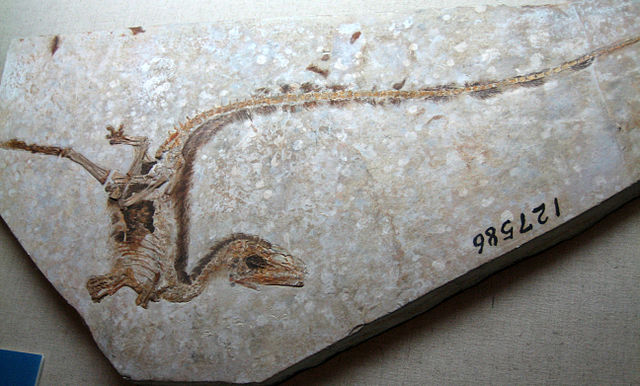
Did dinosaurs really have feathers? A lot did, but, then again, there were a lot that didn’t. And they were more a kind of fluff than the feathers that we see on birds today.
The idea that dinosaurs might have had feathers was first put forward in 1876. A British biologist called Thomas Huxley realized that birds had very similar skeletons to many dinosaur fossils and he suggested that they might be related. He drew feathers on a dinosaur for a lecture he did in New York, and this was the very first suggestion. Since then, evidence has been found and the idea has become mainstream.
Birds are descended from dinosaurs, but not all dinosaurs became birds. They are descended from the two-legged dinosaurs that were called theropods. Tyrannosaurus rex was a theropod. The similarities between birds and these dinosaurs is very clear, apart from their size, obviously. They both have hollow bones and they have a posture where their two legs are underneath their center of balance and counterbalanced by a tail. They both have air pockets in their bones, which keep them lighter and help them to take in more oxygen. They both have wishbones and they both hatch from eggs. And, it seems, they both had feathers. The size difference is more understandable when the factors that made dinosaurs so large, such as the excess oxygen, the temperature, and the abundant food source, disappeared.
The first fossil of a dinosaur with feathers was found in China in 1996. It is important to remember that finding fossils of feathers is very unusual because they are made of keratin, not bone, and they degrade more easily. They also come off the body very easily when the dinosaur dies and don’t lie in the same place for long enough. The only way to know if a dinosaur had feathers is to find the bumps on the bone where the feathers were attached, or to find a feather still attached. The only real way to find fossils of feathers is in the same way that plants and jellyfish are fossilized. The dinosaur has to die in something soft that takes an impression of it, rather than the usual way a fossil is made. This is not very common and it is very rare to find something like this. However, one was found in 1996. The dinosaur was 1.5 meters long and it was a Sinosauropteryx. The area the fossil was found in was an area of very fine-grained sediment and volcanic ash. This was perfect for taking an imprint of even the delicate feathers. This dinosaur had a very light covering of feathers and there was no way that it could have used them to fly. This discovery gave rise to the idea that other dinosaurs might have had feathers, and they were for reasons other than flight.
The area in China where this first feather fossil was found has turned out to be a treasure trove of similar fossils. The ground is perfectly suited to preserving feathers and many different types and sizes of dinosaurs have been discovered. The interesting thing was that most of the dinosaurs were not flying dinosaurs. They had evolved feathers for a different reason. The feathers that most of these dinosaurs have are shorter and fluffier. They are more like a brush than the long feathers that birds today have. The feathers probably served as a layer of insulation. They may also have been a form of camouflage, or even used in mating rituals. And some dinosaurs in the tyrannosaurus family, about the same size as Tyrannosaurus rex, have been found with feathers, which could indicate that the T-rex was most likely feathered as well. However, we shouldn’t confuse these feathers with modern feathers because they were much shorter and fluffier.
An amazing discovery in 2010 managed to find the colors of some of these feathers. There were microscopic pigment cells in some of the fossils that were found. These are called melanosomes, and they give the feathers their colors. The paleontologists could prove that the feathers would have been reddish-brown, and the tail would have been striped. They were able to find green pigments in another dinosaur.
These dinosaurs couldn’t fly and interestingly it is probably when they started to fly that their feathers evolved to be the ones we know today, and they started to shrink in size. The first flying dinosaurs probably had flaps of skin and glided like a flying squirrel. Over time, they might have evolved the ability and the muscles to flap those wings. Whatever feathers they did have would have provided more surface area to their wings, helping with flight. From there, the feathers evolved to be longer, stiffer, and more aerodynamic. And the dinosaurs became smaller because it is far easier for smaller animals to fly than larger ones. And this is what I learned today.
Image By Sam / Olai Ose / Skjaervoy from Zhangjiagang, China – Dinosaurs!, CC BY-SA 2.0, https://commons.wikimedia.org/w/index.php?curid=4209411
Sources
https://eartharchives.org/articles/feather-explosion/index.html
https://australian.museum/learn/dinosaurs/bird-like-dinosaurs
https://www.scientificamerican.com/article/how-dinosaurs-shrank-and-became-birds
https://en.wikipedia.org/wiki/Gigantoraptor
https://en.wikipedia.org/wiki/Feathered_dinosaur
